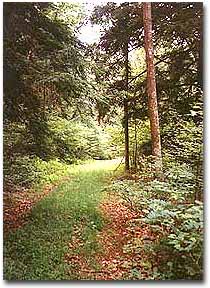 In the 1920s and 1930s, wildlife biologists concentrated on raising game birds to help bolster low populations in the wild. The Billmeyer WMA was purchased for this purpose and game birds were raised in hopes that surplus populations would spread to adjacent lands. Nearby, the Bellgrove WMA was used exclusively for raising wild turkeys. Today this 758-acre tract in Allegany County is no longer a game bird farm. Forests and fields abound with wildlife, providing natural beauty and recreation for many outdoor interests.
In the 1920s and 1930s, wildlife biologists concentrated on raising game birds to help bolster low populations in the wild. The Billmeyer WMA was purchased for this purpose and game birds were raised in hopes that surplus populations would spread to adjacent lands. Nearby, the Bellgrove WMA was used exclusively for raising wild turkeys. Today this 758-acre tract in Allegany County is no longer a game bird farm. Forests and fields abound with wildlife, providing natural beauty and recreation for many outdoor interests.
Billmeyer is situated within the ridge and valley physiographic province, which is characterized by steep slopes. Elevations range from 800 feet in the hollow along Terrapin Run to a high of 1,200 feet along the ridge tops. The property is dominated by mixed oak forest with a few patches of conifers, mostly Virginia pine, with about 25 acres in fields or small wildlife openings.
What To See
Turkeys are abundant here. Hens with their chicks, called "poults," can often be seen pecking through the fields for seeds and insects. In the spring, ruffed grouse drum out their territory and breeding condition on fallen logs. White-tailed deer are a common sight, leaping across the roads and fields. Forest management techniques, which benefit wildlife and produce valuable timber, are demonstrated.
What To Do
Hunters can pursue white-tailed deer, grouse, turkeys, squirrels, woodcock and rabbits. Trapping is also available by permit. Several trails and old logging roads make for an exhilarating day of hiking, with great nature shots for those armed with cameras.
Area Regulations
- Use of Billmeyer WMA is generally permitted seven days a week throughout the year
- Hunting is allowed in accordance with open seasons and shooting hours
- No special permits or drawings are required to hunt this area, except appropriate licenses and stamps.
- Trapping by permit only
- Camping is not permitted, but is available on nearby Green Ridge State Forest.
Non-hunting Users Guide
- Non-hunting visitors are welcome.
- Be aware of open hunting seasons and visit accordingly
- Season dates available in newspapers, on the Internet, and at some area stores
- Trails are maintained but not actively marked
- Bird watching, hiking and mushroom hunting are popular uses of this area.
Site Management Goals
- Billmeyer WMA is managed to provide opportunities for wildlife related recreation.
- Billmeyer's habitat supports good populations of white-tailed deer, wild turkeys, ruffed grouse, woodcock, gray squirrels, and cottontail rabbits.
- County roads are open for year-round access, however maintenance roads and woods trails are gated and closed to vehicular traffic.
- Walk-in access is permitted.
Directions
Take the Orleans Road exit off of I-68, and proceed north to Scenic Route 40. Turn left and travel over Town Hill Mountain. At the bottom of the mountain turn left onto Mountain Road. For additional information, contact the Billmeyer Wildlife Office at (301) 478-2525.
 Click Here for Map
Click Here for Map
This area is a part of Maryland’s Department of Natural Resources public land system and is managed by the Wildlife and Heritage Service. The primary mission of the WMA system is to conserve and enhance wildlife populations and their respective habitats as well as to provide public recreational use of the State’s wildlife resources.
Eighty-five percent of the funding for Maryland's state wildlife programs comes from hunting license fees and a federal excise tax on sport hunting devices and ammunition. The federal aid funds are derived from the Federal Aid in Wildlife Restoration (or Pittman-Robertson) Fund, which sportsmen and women have been contributing to since 1937. Each state receives a share of the funds, which is administered by the U. S. Fish and Wildlife Service; these funds are used for wildlife conservation and hunter education programs, including the management of the WMA system.
Other sources of funds for land acquisition include Program Open Space Funding for Maryland's State and local parks and conservation areas, provided through The Department of Natural Resources' Program Open Space. Established in 1969, Program Open Space symbolizes Maryland's long-term commitment to conserving natural resources while providing exceptional outdoor recreation opportunities.